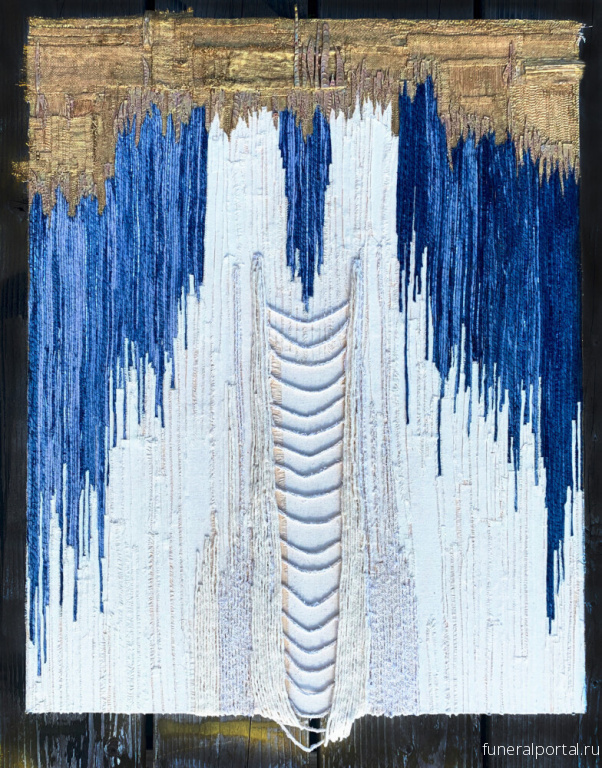Ellie Barnet and Hannah Tarkinson explore death and hope in an exhibition at Moss Galleries in Portland.
BY BOB KEYESSTAFF WRITER

“From Up Here” by Ellie Barnet, an oil-on-canvas painting on view at Moss Galleries. Courtesy of Ellie Barnet
People are uniting in grief as the ravages of COVID-19 cascade across the American landscape. At Moss Galleries in Falmouth, a new exhibition explores two stories of grief through the recent artwork of two Maine artists.
Ellie Barnet and Hannah Tarkinson are showing together in an exhibition called “The Anatomy of In Between,” on view through Sept. 24. A painter, Barnet grieves the loss of her grandmother and a familiar family place in her paintings, while Tarkinson grieves the recent death of her father, who died this summer of COVID-19 after living with Alzheimer’s since 2013, with her mixed-media assemblages. Tarkinson is best known for her jewelry and leatherwork, which she does under the business name Ponomo. This is just her second exhibition of personal artwork.
In spite of the topic, grief does not overshadow what this exhibition is really about, which is hope. Both artists are showing art that looks to the future and honors the memory of their loved ones, either with direct imagery in Barnet’s case, or by incorporating physical elements of her father’s world – pieces of clothes or strings from a musical instrument – in Tarkinson’s. In doing so, they share their hope with the larger community, which is experiencing collective grief associated with the pandemic.
The show’s title, “The Anatomy of In Between,” references the liminal space between life and death and the crossing over associated with it, as well as the uncertain space that all people are living in because of the pandemic.
The artists are studio mates at Running With Scissors in Portland. They bonded over loss and their mutual desire to face that loss head-on, as well as their interest in staying connected to their loved ones after they pass and the curiosities that come with that. Barnet’s grandmother, Elena Barnet – the wife of painter Will Barnet – died four years ago this fall. At the time, Tarkinson was serving as a primary caregiver for her father, Doug Sholl. (Tarkinson’s mother, Betsy Sholl, a former poet laureate of Maine, was the other caregiver.) Barnet gave Tarkinson some of her grandmother’s heirloom jewelry to repurpose, and the creative license to go with it. They have been close friends since.
Barnet’s paintings are informed by family, place and the pandemic. She and her husband and daughter, who turns 5 this fall, decamped to Phippsburg this spring, where Barnet’s mother has operated Rock Gardens Inn for many years. Barnet’s grandparents spent their summers at the inn, which hosted painting workshops for guests.

“Through the Window” by Ellie Barnet. Courtesy of Ellie Barnet
Barnet took over the big studio building that her grandfather had converted for the workshops and made it her painting studio for the season. It was an unexpected gift. The inn had been sold, in theory, and was to open under new ownership this season. But the pandemic scrubbed the deal, forcing Barnet, her parents and family to improvise. With life in flux, they moved to Phippsburg to ride out the pandemic. The inn opened for the season, though it is now closed and back on the market.
Barnet took full advantage of one last summer at the inn. She started some of this work last fall in Portland and finished all of it in Phippsburg. Many of her paintings include double-images, that is, images of family members in the foreground and background of what are otherwise landscape paintings. Including Barnet’s creative hand, there are four generations of females represented here, framed against the backdrop of Phippsburg and family.
“These paintings are really about aloneness, or about family, or motherhood or loss or other individual moments. They’re about paying attention to the moment you are in, which I feel like a lot of people are doing more and more now,” she said.

A detail of “Together Apart In Bloom” by Hannah Tarkinson. Courtesy of Hannah Tarkinson
Tarkinson’s assemblages are equally personal. While caring for her father, she needed a private, solitary creative outlet that provided personal respite and healing. As the disease progressed, Tarkinson’s father amassed small collections of items from his life – broken strings to his autoharp and used tea bags. Tarkinson’s found the beauty in those objects, and repurposed them in wall hangings that also include pieces of his clothes and other physical elements.
She labored to make this work, and found peace in the process. She had no intention of showing it, but decided to share her experience in the alchemy of turning grief into hope.
“I think we can all use some of that now,” she said.









